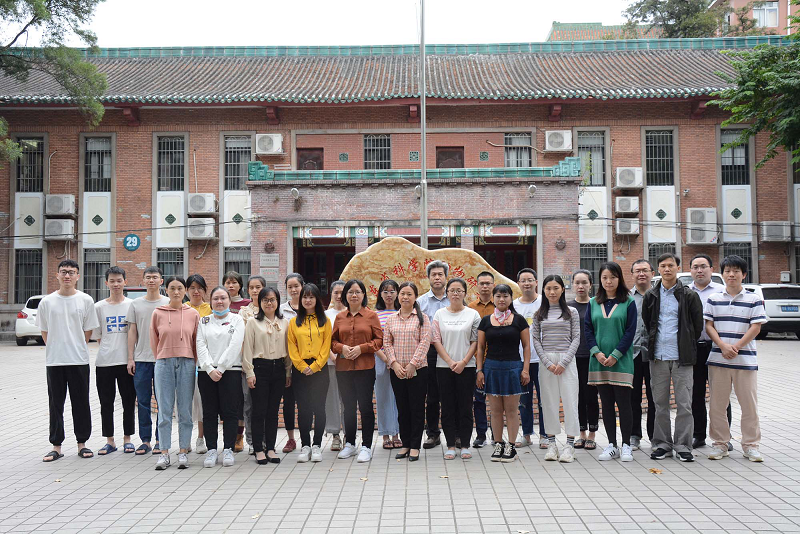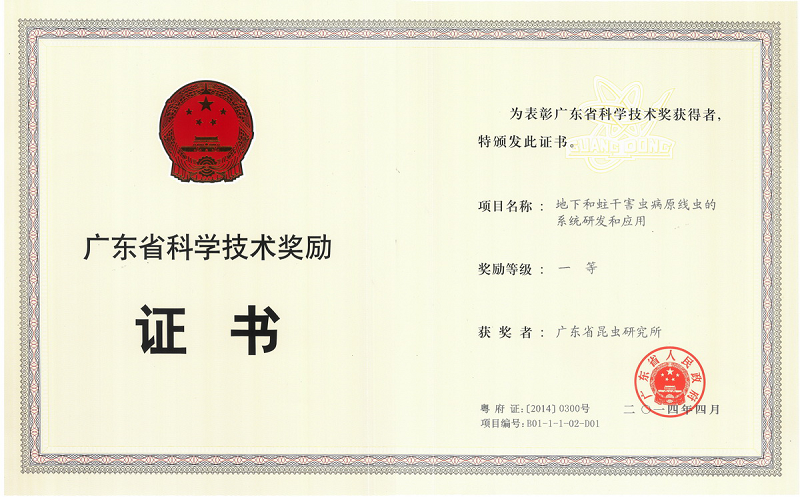Research Center for Resource Insects and Biotechnology
Research Center was established in 1978, with former name entitled Research Group for Entomopathogenic Nematodes. The Center was renamed as the Biotechnology Research Group in 2000 and as Resource Insects and Biotechnology since 2009.
Research Areas
(1) The research, industrialization and application of the novel biological insecticide - entomopathogenic nematodes.
(2) The research and utilization of resource insects (medicinal insects-the Hepialidae insects, pollinators-honey bee, feed insects-house fly) and their functional genes.
(3) The research and application of biotechnology (fermentation engineering, genetic engineering, biochemistry etc.).
Research Progress
In the post 20 years, the Research Center has undertaken more than 80 important research projects, including international cooperation projects [such as projects from Australian Centre for International Agricultural Research (ACIAR), International Foundation for Science (IFS), the European Union Fifth and Seventh Framework Program (FP5 and FP7), Flemish Interuniversity Council and UK Department for International Development (DFID)], projects supported by the National Natural Science Foundation of China, Natural Science Foundation of Guangdong Province, and other projects supported by local government.
The research center has obtained 9 academic prizes from national and provincial levels; 83 applied national invention patents (including55 authorized patents and 6 international authorized patents; more than 160 research papers including more than 70 papers in SCI source; 4 English books with chapters in “Microbial Control of Insect and Mite Pest”, “Entomopathology Nematology”, “Application of Entomopathogenic Nematodes”, “Mass production of Beneficial organisms”, and 1 Chinese book with chapter in “Biological Control for Pest”; 18 corporate standards; and 38 trained Master students, 11 PhD students, and 3 postdoctoral fellows since 2001.
科研方向
主要从事生物杀虫剂产业化, 资源昆虫研发, 以及天然活性代谢产物发现与药效活性挖掘。
科研团队组成
中心主任:韩日畴博士、研究员(二级),中国昆虫学会副理事长,广东省昆虫学会理事长;中国科学院大学、中山大学和比利时根特大学等博士生导师。从事生物农药和资源昆虫研发。
二级PI:
曹莉硕士、研究员,硕士研究生导师;从事生物农药产业化和冬虫夏草研发。
李文峰博士、副研究员,硕士研究生导师;从事蜜蜂化学通讯和病虫害研究。
张祎博士、副研究员,硕士研究生导师;从事要从事蜜蜂病理与病虫害防治研究。
科研成果概况、近五年科研成果列表
近五年发表的主要学术论文:(*为通讯作者)
1. Long H, Qiu X, Cao L, Liu G, Rao Z, Han R*. Toxicological safety evaluation of the cultivated Chinese cordyceps. Journal of Ethnopharmacology, doi.org/10.1016/j.jep.2020.113600 (IF=3.69, 药物学1区)
2. Wu H, Rao Z, Cao L, De Clercq P*, Han R*. Infection of Ophiocordyceps sinensis fungus causes dramatic changes in the microbiota of its Thitarodes host, Frontiers in Microbiology , doi.org/10.3389/fmicb.2020.577268 (IF=4.235, 生物2区)
3. Liu G, Lv Z, Wu Q, Zhou Z, Zhang G, Wan F*, Yan Y. The Bactrocera dorsalis caspase1 gene is expressed throughout development and required for female fertility, Pest Management Science, 2020, DOI: 10.1002/ps.5966. (IF=3.252, 生物1区)
4. Liu G, Cao L, Rao Z, Qiu X, Han R*. Identification of the genes involved in growth characters of medicinal fungus Ophiocordyceps sinensis based on Agrobacterium tumefaciens-mediated transformation. Applied Microbiology and Biotechnology, 2020, 104(6): 2663-2674. doi: 10.1007/s00253-020-10417-1. (IF=3.67, 工程技术2区)
5. Qiu X, Cao L, Han R*. Analysis of volatile components in different Ophiocordyceps sinensis and insect host products. Molecules, 2020, 25: pii: E1603. doi: 10.3390/molecules25071603. (IF=3.06, 化学3区)
6. Liu G, Cao L, Qiu X, Han R*. Quorum sensing activity and hyphal growth by external stimuli in the entomopathogenic fungus Ophiocordyceps sinensis. Insects, 2020, 11(4). pii: E205. doi: 10.3390/insects11040205. (IF=2.137, 农林科学2区)
7. Wang Tao, Keller A. Michael*. Larger is better in the parasitoid Eretmocerus warrae (Hymenoptera: Aphelinidae). Insects, 2020, 11:39. (IF=2.137, 农林科学2区)
8. Rao Z, Cao L, Wu H, Qiu X, Liu G, Han R*. Comparative transcriptome analysis of Thitarodes armoricanus in response to the entomopathogenic fungi Paecilomyces hepiali and Ophiocordyceps sinensis. Insects, 2020, 11(1): pii: E4. doi: 10.3390/insects11010004. (IF=2.137, 农林科学2区)
9. Yan X, Shahid Arain M, Lin Y, Gu X, Zhang L, Li J, Han R*. Efficacy of entomopathogenic nematodes against the tobacco cutworm, Spodoptera litura (Lepidoptera: Noctuidae). Journal of Economic Entomology, 2020, 113(1): 64-72. doi: 10.1093/jee/toz262. (IF=1.779, 昆虫学2区)
10. Li W, Wang C, Huang ZY, Chen Y, Han R*. Reproduction of distinct Varroa destructor genotypes on honey bee worker brood. Insects, 2019, 10(11): pii: E372. doi: 10.3390/insects10110372. (IF=2.137, 农林科学2区)
11. Rao Z, Cao L, Qiu X, Han R*. Comparative transcriptome analysis reveals molecular strategies of ghost moth Thitarodes armoricanus in response to hypoxia and anoxia. Journal of Insect Physiology, 2019, 112, 23-34. doi: https:// doi.org/10.1016/j.jinsphys.2018.11.001. (IF=2.862, 农林科学2区)
12. Zhang Y, Han R*. Insight into the salivary secretome of the Varroa destructor and salivary toxicity to Apis cerana. Journal of Economic Entomology, 2019, 112(2):505-514. doi: 10.1093/jee/toy224. (IF=1.779, 昆虫学2区)
13. Yan X, Zhao G, Han R*. Integrated management of chive gnats (Bradysia odoriphaga Yang & Zhang) in chives using entomopathogenic nematodes and low-toxicity insecticides. Insects, 2019, 10(6): pii: E161. doi: 10.3390/insects10060161. (IF=2.137, 农林科学2区)
14. Liu G, Han R, Cao L*. Artificial cultivation of the Chinese cordyceps from injected ghost moth larvae. Environmental Entomology, 2019, 48(5): 1088-1094. (IF=1.45, 昆虫学3区)
15. Liu G, Qiu X, Cao L, Han R*. Scratching stimuli of mycelia influence fruiting body production and ROS-scavenging gene expression of Cordyceps militaris. Mycobiology, 2018, 46(4): 382–387. (IF=1.369, 真菌学4区)
16. Zhang Y, Han R*. A saliva protein of Varroa mites contributes to the toxicity toward Apis cerana and the DWV Elevation in A. mellifera. Scientific Reports, 2018, 8(1): 3387. doi: 10.1038/s41598-018-21736-9. (IF=4.259, 综合性期刊3区)
17. Yan X, Lin Y, Huang Z, Han R*. Characterization of biological and biocontrol traits of entomopathogenic nematodes promising for control of striped flea beetle (Phyllotreta striolata). Nematology, 2018, DOI: 10.1163/15685411-00003155. (IF=1.216, 动物学3区)
18. Guo W, Yan X, Zhao G, Han R*. Increased efficacy of entomopathogenic nematode-insecticide combinations against Holotrichia oblita. Journal of Economic Entomology, 2017, 110(1): 41-51. (IF=1.779, 昆虫学2区)
19. Guo W, Yan X, Han R*. Adapted formulations for entomopathogenic nematodes, Steinernema and Heterorhabditis spp. Nematology, 2017, 19(5): 587-596. (IF=1.216,动物学3区)
20. Liu G, Qiu X, Cao L, Zhang Y, Han R*. Evaluation of reference genes for reverse transcription quantitative PCR Studies of physiological responses in the ghost moth, Thitarodes armoricanus (Lepidoptera, Hepialidae). PLOS ONE, 2016, 11(7): e0159060. doi: 10.1371/journal.pone.0159060. (IF=2.806, 综合性期刊3区)
21. Zhang J, Zhang Y, Han R*. The high-throughput production of dsRNA against sacbrood virus for use in the honey bee Apis cerana (Hymenoptera: Apidae). Virus Genes. 2016, 52(5): 698-705. doi: 10.1007/s11262-016-1346-6. (IF=1.616, 病毒学4区)
22. Zhan Z, Qiu X, Han R*. Horizontal transfer of the C-termini of tccC genes in Photorhabdus and Xenorhabdus. Genes & Genomics, 2016, 38(8): 685-692. DOI: 10.1007/s13258-016-0410-x. (SCI,分子生物学4区)
23. Qiu X, Wu C, Cao L, Ehlers RU, Han R. Photorhabdus luminescens LN2 requires rpoS for nematicidal activity and nematode development. FEMS Microbiology Letters, 2016, 363(6): doi: 10.1093/femsle/fnw035. (IF=1.765, 微生物4区)
24. Yan X, Waweru B, Qiu X, Hategekimana A, Kajuga J, Li H, Edgington S, Umulisa C, Han R*, Toepfer S. New entomopathogenic nematodes from semi natural and small-holder farming habitats of Rwanda. Biocontrol Science and Technology, 2016, 26 (6): 820-834. (SCI,昆虫学4区)
25. Tao Z, Cao L, Zhang Y, Ye Y, Han R*. Laboratory Rearing of Thitarodes armoricanus and Thitarodes jianchuanensis (Lepidoptera: Hepialidae), Hosts of the Chinese Medicinal Fungus Ophiocordyceps sinensis (Hypocreales: Ophiocordycipitaceae). Journal of Economic Entomology, 2016, 109(1): 176-781. (IF=1.824, 昆虫学2区 )
26. Cao L, Ye Y, Han R*. Fruiting body production of the medicinal Chinese caterpillar mushroom, Ophiocordyceps sinensis (Ascomycetes), in artificial medium. International Journal of Medicinal Mushrooms, 2015, 17(11): 1017–1022. (IF=1.357, 真菌学4区)
27. Jiang K. Han R*. Rhf1 gene is involved in the fruiting body production of Cordyceps militaris fungus. Journal of Industrial Microbiology & Biotechnology, 2015, 42(8): 1183–1196. (IF=2.745, 生物工程与应用微生物3区)
28. Zheng Z, Qiu X. Han R*. Identification of the genes involved in the fruiting body production and cordycepin formation of Cordyceps militaris Fungus. Mycobiology, 2015, 43(1): 37-42. (SCI, 真菌学4区)
29. Guo W, Yan X, Zhao G, Chen J, Han R*. Efficacy of entomopathogenic Steinernema and Heterorhabditis nematodes against Holotrichia oblita. Journal of Pest Science, 2015, 88: 359-368. (IF=3.107, 昆虫学1区)
专著编写
1.Peters A, Han R, Yan X, Leite LG. Chapter 10. Production of Entomopathogenic Nematodes. In: Lacey L.A. (ed.) Microbial Control of Insect and Mite Pest4s: From Theory to Practice. 2017. Elsevier.
2.Shapiro-Ilan DI, Han R, Qiu X. Chapter 10 - Production of Entomopathogenic Nematodes. In: Mass Production of Beneficial Organisms, Academic Press, 2014, Pages 321-355.
3.Shapiro-Ilan DI, Duncan LW, Lacey LA and Han R. Orchard crops. In: Nematodes As Biocontrol Agents (edited by Grewal PS, Ehlers R-U and Shapiro-Ilan DI), CABI Publishing, 2005, Pages 215-229. 2004.03
4.Gaugler R, Han R. Production technology. In: Entomopathogenic Nematology (edited by Gaugler R), CABI Publishing, 2001, Pages 289-310. 2001.03
5.韩日畴, 丘雪红. 昆虫病原线虫的利用.《害虫生物防治》林乃铨主编, 科学出版社,2010, p.287-314. 2010.04
发明专利
近五年授权发明专利 22(其中国际授权专利6件):
1.郭文秀,韩日畴,颜珣. 国家发明专利:腐殖土作为载体在贮存昆虫病原线虫中的应用. 专利号:ZL201710297018.6;授权公告日:2020.10.20.
2.陈镜华,丘雪红,韩日畴. 国家发明专利: 一种白蚁诱饵、白蚁诱杀装置及其制造方法. 专利号:ZL2017101216308;授权公告日:2020.10.15.
3.刘桂清,曹莉,丘雪红,韩日畴. 国家发明专利:一种冬虫夏草菌液体培养基及高效获得冬虫夏草寄主昆虫感染用芽生孢子的方法. 专利号:ZL201810513326.2;授权公告日:2020.10.12.
4.张祎,韩日畴. 国家发明专利:一种蜜蜂西奈湖病毒基因组扩增引物和扩增方法及其应用. 专利号:ZL201710279245.5;授权公告日:2020.07.28.
5.张祎,韩日畴. 国家发明专利:一种快速检测蜜蜂丝状病毒的检测引物组、检测试剂盒和检测方法. 专利号:ZL201710278715.7;授权公告日:2020.07.07.
6.Qiu X, Han R. 美国发明专利:Artificial diet for ghost moth larvae and preparation method therefor. 美国专利号:US10681921B2;授权日:2020.06.16.
7.Cao L, Han R. 美国发明专利:Artificial feeding method at low altitude for host insect ghost moth of Ophiocordyceps sinensis. 美国专利号:US10412941B2, 授权日:2019.09.17.
8.Cao L, Han R. 美国发明专利:Method for artificial cultivation of Ophiocordyceps sinensis fruiting bodies. 美国专利号:US10400209B2, 授权日:2019.09.03.
9.Qiu X, Han R.日本发明专利:Artificial diet for ghost moth larvae and preparation method therefor.日本特许证,特许第6535419号;授权日:2019.06.07.
10.颜珣,韩日畴. 国家发明专利:一种快速获得小卷蛾斯氏线虫整齐龄期感染期幼虫的方法. 专利号:ZL201610257254.0;授权公告日:2018.10.23.
11.丘雪红,韩日畴. 国家发明专利:一种蝙蝠蛾幼虫的人工饲料及其制备方法. 专利号:ZL201610938312.6;授权公告日:2018.07.20.
12.张祎,韩日畴. 国家发明专利:一种狄斯瓦螨唾液混合物及其制备方法和应用. 专利号:ZL201410217111.8;授权公告日:2018.02.23.
13.张祎,韩日畴. 国家发明专利:一种狄斯瓦螨毒性蛋白及其编码基因和应用. 专利号:ZL201410217113.7;授权公告日:2018.01.19.
14.Cao L, Han R. 日本发明专利:Method for artificial cultivation of Ophiocordyceps sinensis fruiting bodies. PCTCN2014092747.日本特许证,特许第6143245号;授权日:2017.05.19.
15.Cao L, Han R. 日本发明专利:Artificial feeding method at low altitude for host insect ghost moth of Ophiocordyceps sinensis. PCTCN2014092751. 日本受理号:51601181471,日本特许证,特许第6143246号;授权日:2017.05.19
16.丘雪红,韩日畴. 国家发明专利:珠芽蓼根在制备小菜蛾与斜纹夜蛾杀虫剂中的应用. 专利号:ZL201510680995.5;授权公告日:2017.11.21.
17.江克清,韩日畴. 国家发明专利:一种能提高蛹虫草感染寄主昆虫能力的蛹虫草工程菌. 专利号:ZL201410218655.6;授权公告日:2017.01.25.
18.丘雪红,胡素丽,韩日畴. 国家发明专利:转录因子DksA基因的新用途. 专利号:ZL201410328197.1;授权公告日:2016.08.17.
19.陈镜华,韩日畴,颜珣. 国家发明专利:一种食用/药用/饲用昆虫的干燥设备. 专利号:ZL201410103884.3;授权公告日:2016.04.20.
20.江克清,韩日畴. 国家发明专利:一种蛹虫草Rhf1基因失活的工程菌以及蛹虫草Rhf1基因的应用. 专利号:ZL201410217012.X;授权公告日:2016.02.24.
21.曹莉,韩日畴. 国家发明专利:一种冬虫夏草寄主昆虫蝙蝠蛾的人工低海拔饲养方法. 专利号:ZL 201410413333.7;授权公告日:2015.08.19.
22.曹莉,韩日畴. 国家发明专利:一种冬虫夏草子实体人工栽培方法. 专利号:ZL201410289703.0;授权公告日:2015.05.20.
科技奖项
1.2016年度广东发明人奖,韩日畴,授奖时间:2017.07.
2.广东省科学技术奖一等奖:地下和蛀干害虫病原线虫的系统研发和应用;授奖时间:2014.04, 第一完成单位.
3.国家科技技术进步奖二等奖:有机固体废弃物资源化与能源化综合利用系列技术及应用;授奖时间:2011.12.23, 第五完成单位.
4.国家科技技术进步奖二等奖:桔小实蝇持续控制基础研究及关键技术集成创新与推广;授奖时间:2009.12.23, 第七完成单位.
5.山东省科学技术奖科技进步奖三等奖:昆虫病原线虫防治韭蛆等园艺害虫研究与开发;授奖时间:2007.04.29. 第二完成单位.
6.广东专利奖优秀奖:韩日畴 李丽英, 一种昆虫病原线虫的液体培养方法.
7.广东省科学技术奖二等奖:昆虫病原线虫的液体发酵生产; 授奖时间:2005.05, 第一完成单位.

团队照片

科研成果或奖项照片(一张)

